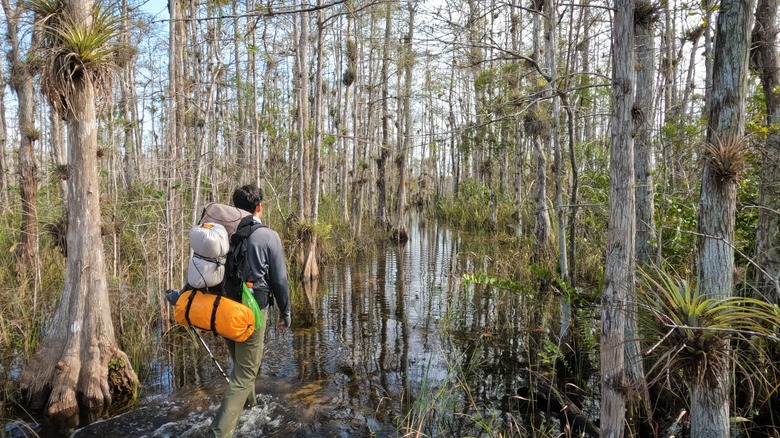This Florida Preserve Full Of Wildlife Is A Lot Like Everglades National Park But Free
There's no doubt that Everglades National Park is one of the most iconic national parks on the East Coast. But if you drive less than 10 minutes away, you could be in an equally fascinating wildlife habitat: Big Cypress National Preserve. If you're exploring South Florida on a budget, there's no reason to pass this up; it won't add a dime to your expenses. While you'll have to pay between $20 and $35 if you want to spend the day at Everglades, you can visit Big Cypress for free any day of the year.
Big Cypress stretches an impressive 729,000 acres, which are home to a wide variety of beautiful creatures. It's no surprise that this preserve seems a lot like Everglades at first glance. Like nearby Everglades, Big Cypress contains partially flooded prairie landscape, but it also has a forest of old cypress trees growing out of the water, mangroves in brackish estuaries, elevated regions of solid ground covered in lush vegetation, and pinelands where a rich grassland thrives under the canopy of South Florida slash pines. Just like Everglades National Park, this is the perfect place to spot alligators, but you might also see everything from Big Cypress fox squirrels to manatees. While you probably won't be able to see an elusive Florida panther, you can rest assured that they are still there, thanks to this unique preserve.
See the incredible wildlife in Florida's national preserve
Visitors to Big Cypress National Preserve are able to catch glimpses into its unique ecosystems and see the incredible wild animals that live there in their natural habitats. Everglades National Park is famously the one spot in the world where you can see both wild alligators and crocodiles, and while you'll likely see many alligators, there's only been one proven crocodile sighting at Big Cypress — but there are many more wild creatures to see. Big Florida black bears, long-nosed Florida softshell turtles, and vibrant pink roseate spoonbills all call this incredible place home.
From the singing of Eastern lubber grasshoppers in the grass to the cries red-shouldered hawks in the skies, this park is teeming with life — but if you want to have the best chance of seeing animals during your visit, you should try to come in the dry season: November-April. While you might have to compete with other visitors for views at the most popular spots, the park also comes alive with migrating birds while the other animals are pushed into the remaining areas of deeper water.
Immerse yourself in nature at Big Cypress
Big Cypress may be the perfect habitat for wild creatures, but there's still plenty for visitors who don't have fins, scales, or webbed feet to enjoy. Although it isn't free, if you're looking to spend the night in the park, you can often reserve a campsite for between $10-30, depending on which you choose. Best of all, Big Cypress is an International Dark Sky Place, which means that it's one of the best parks in America for stargazing.
If you're hoping to lock eyes on some of the animals who make this preserve their home, your best bet may be hiking through the wilderness. If you want to truly explore the wild places of Florida, you can apply for a free backcountry permit and wade into the swamps. If you're not looking to get that in touch with nature, however, there are established trails like the Kirby Storter Roadside Park Boardwalk, Gator Hook Trail, and Fire Prairie Trail, which provide incredible views of the marshy landscape from the security of the (relatively) dry land. There are also a few scenic drives that will let you appreciate the preserve from the comfort of your vehicle.
